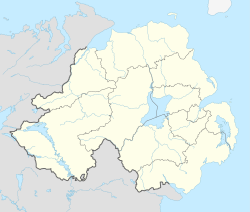Gracehill Moravian Church
| Gracehill Moravian Church | |
|---|---|
 | |
| Coordinates | 54°51′12″N 6°19′39″W / 54.85345°N 6.32755°W |
| Built | 1759 |
Listed Building – Grade A | |
Gracehill Moravian Church is the church of the Moravian settlement of Gracehill, County Antrim in Northern Ireland. A prominent feature is the raised pulpit, reflecting the importance Protestant churches give to preaching. The organ, which is in one of the galleries, is also prominent.[1]
History
[edit]A number of Moravian congregations were established in Ulster,[2] and some survive, but the Moravian Church only has a small presence on the island of Ireland. As a planned Moravian settlement, Gracehill is unique not only in Ulster, but in Ireland.[3] Gracehill Moravian Church was founded in 1759.[4] The village was built around the church and the church owned all of the buildings in the village as a result.[5] The church established the village with it being planned to be separated into a male and female side either side of the church.[6]
During the Irish Rebellion of 1798, United Irishmen rebels attempted to intimidate the church into joining the rebellion, the church refused with only one adherent joining the armed rebellion but the church later provided sanctuary to rebels fleeing government forces.[7] Gracehill also acted as a repository for Moravian Church records in Ireland, with Moravian churches as far as Dublin storing official church records at Gracehill.[8]
Conservation
[edit]The 18th-century building has had a heritage listing (Grade A listed) since 1975, with the whole area around it being designated as Northern Ireland's first conservation area.[9] The pulpit was noted as being along the longest wall of the church rather than conventionally at the front.[10] In 2024, the church and village of Gracehill was declared a World Heritage Site.[11]
References
[edit]- ^ "Antrim, Gracehill, Moravian Church". British Pipe Organ Register. Retrieved 7 April 2025.
- ^ Hanna, Samuel George (1967). "The Origin and Nature of the Gracehill Moravian Settlement, 1764-1855, with Special Reference to the Work of John Cennick in Ireland, 1746-1755". Transactions of the Moravian Historical Society. 21 (2). JSTOR 41179384. Retrieved 7 April 2025.
- ^ "Gracehill: Antrim Moravian village awarded World Heritage status". BBC News. 26 July 2024. Retrieved 7 April 2025.
- ^ "Gracehill Moravian Church joins UNESCO world heritage list". The Irish News. 26 July 2024. Retrieved 7 April 2025.
- ^ "Gracehill: 'It's special because it's kept its authenticity'". BBC News. 26 July 2024. Retrieved 7 April 2025.
- ^ "Moravian Church Settlements Across Four Countries Inscribed on the UNESCO World Heritage List". 0.0.0.0. 26 July 2024. Retrieved 7 April 2025.
- ^ Beiner, Guy (2018). Forgetful Remembrance. Oxford University Press. p. 482. ISBN 9780198749356.
- ^ Maxwell, Ian (1997). Tracing Your Ancestors in Northern Ireland. HM Stationery Office. p. 27. ISBN 9780114958237.
- ^ "UK Tentative List of Potential Sites for World Heritage Nomination" (PDF). Department of Media, Culture and Sport. Retrieved 7 April 2025.
- ^ "Gracehill -Where Time Stands Still". BBC. Retrieved 7 April 2025.
- ^ "Moravian Church Settlements". UNESCO World Heritage Centre. Retrieved 28 July 2024.

